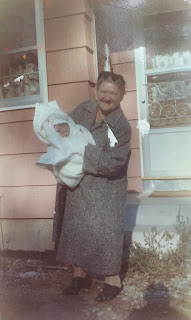 |
| Mary Urban Endrich holding Linda Louise Nelson on her first day home. |
Many of these photos are more than 100 years old, taken at the turn of the 20th century. Some pre-date that and traveled here from Bohemia in the late 19th century, or were taken in New York City studios during that same period as boats landed from Bremen and other European ports.
I've started with my grandmother Mary Urban Endrich whom, as you may remember from previous posts, was of great import to me. My parents built their house next door to hers, on a portion of the 15+ acres of Endrich land purchased by her husband, Richard, in 1919 and which she deeded to them.
She was 63 years old in this photo on the day I was first brought to my adopted home from Catholic Charities. This photo, from October 1961, was taken on the back steps -- forever unfinished -- of the house my parents built.
Mary had a large garden that formed the buffer between our house and hers. In this second photo you can see her standing tall amongst zinnias and sunflowers with our 1950's pink ranch in the background. In addition to the flowers, bouquets of which she sold with my toddler "assistance" from a roadside table along the main route running up the Connecticut River between Old Saybrook and Middletown, where I was born; New Britain, where my dad was from; and Hartford, the state capital, Mary also grew squash, cucumbers, corn and tomatoes which fed us all summer and into the fall.
 |
| Mary in her garden, Old Saybrook, CT |
Mary was my primary Bohemian.
"Send the little girl over!" she'd bellow to my mother in her everyday stage voice across the garden and away I'd go down the small hill and along the mowed path on my stubby legs. Especially after the arrival of my brother, also adopted, when I was two and a half, it seems I was at Mary's every day: learning to read, to write, to play her made up game of Stars with paper, pencils, and a breadcrumb, to explore the attic with her, to problem solve, learning to phone home and unlock the door when she went into one of her "states."
Her father, Frantisek, took work as a butcher in the East Village when they first landed in NYC in 1892 but between 1900 and 1910 he was able to buy a farm in Killingworth, CT, and was thereafter recorded in census documents as a self-employed farmer. Mary came by her gardening honestly. You can see that one of the early photos of her in the collage below is posed with two other girls in a cabbage patch!
I was unaware that cameras were popularly available beginning in 1900 when the first Brownie was invented. Every snapshot taken of us as kids was taken on my Mom's Eastman Kodak Brownie, a far cry in the 1960's from the humble box camera my grandmother's family obviously owned once they got to Connecticut.
 |
| A Brownie 2 Camera circa 1910. |
And still. These cardboard box cameras, which churned out photos of my young, beautiful, charismatic, energetic grandmother from age 18 through her marriage at 22, cost around $3, the equivalent of $82 today.
Not bad for farmers.
In addition to their existence, the photos expose a sense of prosperity one no longer assumes belongs to farmers at the beginning of the 20th century. In these photos, Mary is decked out in numerous stylish hats, dresses, and lace. Her brothers in high collars and ties, lace curtains as their backdrop.
Who is this Mary? I never saw her in all these hats, never saw her in anything more than simple farm house dresses. Where did the money come from for the Urban's to "buy the farm"? How did she meet my grandfather, Richard, who on his 1917 WWI draft registration card described himself as a ship fitter and seems to have come to Essex, CT from the Bronx to work at the Dauntless Shipyard? Who, in July of 1919, purchased the 15+ acres on the Essex/Old Saybrook town line on which my mother, aunt, and uncle were born and on which I grew up? They married the next year, on November 24, 1920. Richard was 31, 10 years older than Mary.
Richard was gone, of colon cancer, by the time of my arrival. But my uncle Richie, and several of Richard's siblings, all worked at the Pratt-Reed piano works in Ivoryton. No more shipyards.
The many mysteries continue.
 |
| The many mysteries of Mary. |


No comments:
Post a Comment